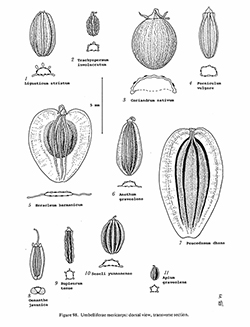e-Flora of Thailand
Volume 5 > Part 4 > Year 1992 > Page 469 > Umbelliferae > Heracleum
Heracleum birmanicum Kurzwfo-0001069132
J . Asiat. Soc. Bengal 41 (2): 309. 1872; 46(2): 116. 1877 (as H. birmanicum); C.B.Clarke in Fl. Br. Ind. 2: 714. 1879; Craib in Fl. Siam. En. 1: 792. 1931; Smitinand, Nat. Hist. Bull. Siam. Soc. 21: 105. 1966; Wang Jiehseng in Fl. Reip. Pop. Sini. 55.3: 199. 1992. Fig. 98: 5.
Accepted Name : Tetrataenium birmanicum (Kurz) Manden.
(Kurz) Mandenova, Not. Syst. Geogr. Inst. Bot. Tbilisi 41: 46. 1986.
Synonyms & Citations :
Description : Perennial; stems erect, up to 2 m, ca 8–10 mm thick near base, fistulose or not, finely striate, leafy, ± glabrous below, often with short ± retrorse straight hairs above. Leaves 1–2 times trisect, variable in size and texture; leaflets of middle cauline leaves narrow oblong obovate to ovate-triangular, ca 5–7(–12) by 3–5 cm, ± irregularly serrate to serrate lobed; indumentum of scattered papillae-like hairs mainly on veins of abaxial surface; petioles of flower leaves up to ca 20 cm, somewhat sheathing at base. Peduncles (1–)2–18(–20) cm. Umbels mostly termina 1. Bracts present, deciduous or persisting. Rays 15–20, angled, ± densely pubescent, to 6 cm. Bracteoles several, ca 6–7 mm, deflexed, narrow linear-triangular, acuminate, shorter than pedicels. Sepals unequal, 0.5–1 mm, persistent in fruit or deciduous. Petals 1.5–3 mm, radiant (?), white or greenish-white. Fruit 8–12 by 7–8 mm, elliptic to ± obovate, apically rounded acute to obtuse-emarginate, glabrous or finely papillose; ridges distinct; vittae 1–3 per valleculae; commissural 2–several.
Thailand : NORTHERN: Chiang Mai (Doi Chiang Dao – type of Heracleum siamicum, Doi Inthanon, Doi Pha Hom Pok, Doi Suthep), Chiang Rai (Doi Tung), Lampang (Mae Pu); SOUTH-WESTERN: Kanchanaburi (Huai Ban Kao, Bo Rae – type of H. siamicum var. gracilis).
Distribution : Assam, Burma (type), SW China.
Ecology : Mixed and evergreen forests, crevices in limestone rocks, grassy fields, 330–2,250 m alt.
Vernacular : Ma laep (มะแหลบ), thiantakkataen(เทียนตั๊กแตน)(Northern).
Uses: The label on Wmn 1800 (Mae Pu) records “Leaves and stalks used for flavouring curries; seed is one of the most esteemed spices in northern Siam”.
Notes: The available material from Thailand is inadequate for making taxonomic decisions and the type specimens of both Heracleum birmanicum and H. siamicum (which lacks even juvenile fruit) are far from ideal. The stems may apparently be either fistulose or solid, the leaflets range from narrow oblong (to ± linear) to broad ovate-triangular, the peduncles 1–20 cm, the fruit apex may be subacute to obtuse-emarginate and the vittae vary in number. This is an unusually wide range of character states even in a polymorphic species. Although further gatherings and field studies may reveal that combinations of these characters can define separate taxa, we decided that it was premature to do so. Came (Fl. Siam. En. l.c.) pointed out that “the Burmese collections at Kew (Winit 1800, Kurz, Parish) were quite distinct from the Khasian and Chinese collections referred to H. barmanicum”; we tend to agree. A revision of all the material is much needed, including H. bivittatum H.Boiss. From SW China, Vietnam and Laos.

